Rennie Scaysbrook | December 18, 2017
It’s 1973 all over again with the brand-new Kawasaki Z900RS. Does the son live up to the legendary father?
2018 Kawasaki Z900RS | FIRST RIDE | You must admire the human psyche for its fondness of yesterday. Things were always better back in your day, no matter whether your day was last week or last century. We love things that remind us of simpler times, of times when we were young, rowdy and ready for anything.
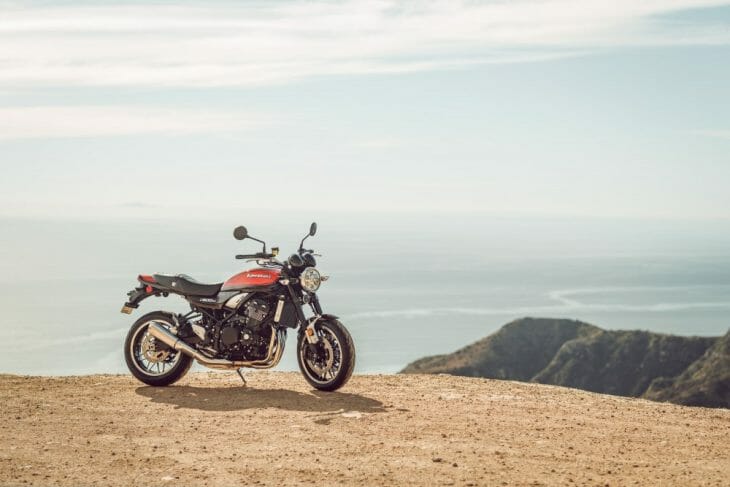 California dreamin’ on a Kawasaki Z900RS. The second coming doesn’t have the rage of the Z1, but that’s a good thing.
California dreamin’ on a Kawasaki Z900RS. The second coming doesn’t have the rage of the Z1, but that’s a good thing.
Often, times really were better way back when. And while we are definitely not worse off as motorcycle riders than our moms and dads, it is nice to give a little nod to the past while keeping your feet firmly in the present.
This is what Kawasaki is doing with the 2018 Z900RS and the 900RS Café (which, oddly, is not coming to the U.S.–yet). The 900RS is the kid going to a fancy-dress party in dad’s old Z1 900 clothes—it’s a modern version of the bike that blew everyone away in the winter of 1972-73.
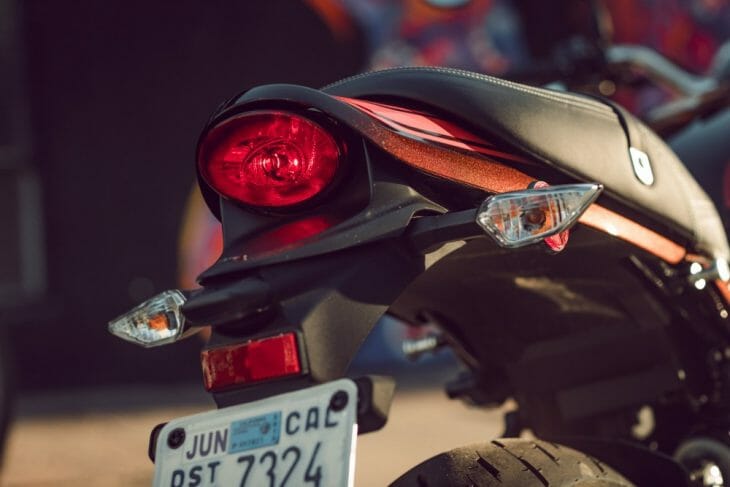 The rear seat and light are straight off a Z1.
The rear seat and light are straight off a Z1.
Yet the 900RS is not trying to emulate dad’s history as the new king superbike. Dad may have been full of that piss and vinegar that fueled the 1970s-motorcycle boom, but the kid is more chilled out and ready to take things a little easier.
The 900RS uses Kawasaki’s 2017 Z900 nakedbike as its base but gets a host of changes to take on its time warp. A revised engine, different brakes, riding position and most significantly, totally reworked styling that gives the RS a completely different demeanor and feel when you’re out riding.
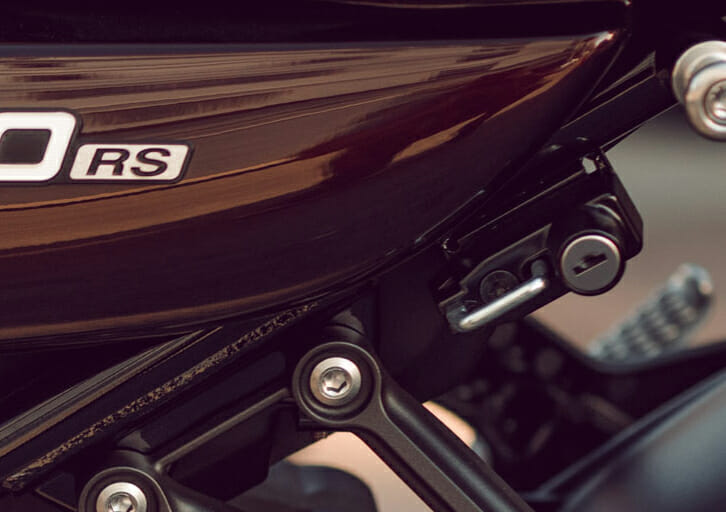 Let’s just take a moment to applaud Kawasaki for bringing back the helmet lock. Now, Kawasaki, please put it on every bike you sell. Every one.
Let’s just take a moment to applaud Kawasaki for bringing back the helmet lock. Now, Kawasaki, please put it on every bike you sell. Every one.
As a styling exercise, Kawasaki has nailed the new RS. The large, circular LED headlight; dual round analogue clocks, air-cooled-style engine fins on the block; cast wheels that have the flat spokes polished to give an old-school wire-spoked appearance; the wide and long single piece seat; the helmet lock (rejoice!); the teardrop tank shape and color and the little dovetail seat unit are all classic Z1 900. Transported out of the ’70s, they give you the feeling of being right back in them. But those thoughts are quickly erased when you fire up the inline four-cylinder and hear the rasp of Kawasaki’s first tuned exhaust note.
Kawasaki went to such lengths with the RS, they employed a bunch of sound technicians to ensure the exhaust note is as close to the original Z1 900 as they could get. The result is a deep, burbling noise that’s totally departed from the softer, more modern sound of the Z900.
Time Traveling
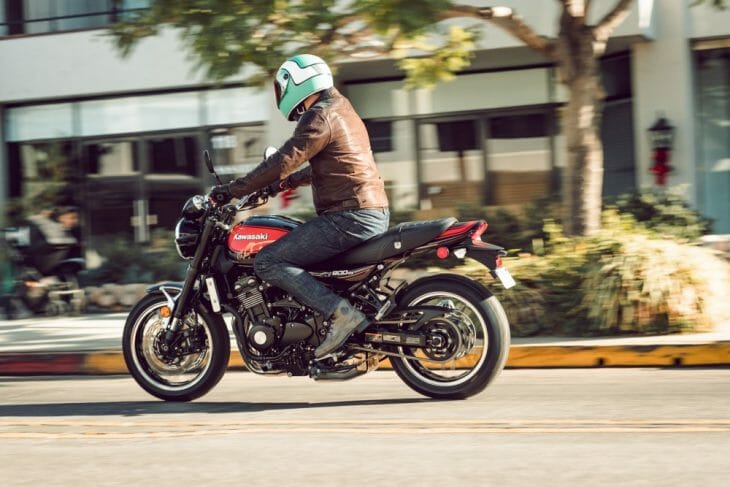 The ride position is about as comfortable as could possibly be for a nakedbike.
The ride position is about as comfortable as could possibly be for a nakedbike.
Clicking first gear and rolling away, it’s clear this is one of the most comfortable roadsters/nakedbikes available today. The engineers have done a brilliant job with the seat design, making it look great but also super comfortable for a full day in the saddle. The rider triangle of handlebar, seat, and footpeg is about as relaxed as you’re ever going to find on a modern machine—which is odd considering this bike is trying to be from the ’70s.
The handlebar shape and position is absolutely spot-on for big days in the saddle. Compared to the Z900 it’s 30mm wider, 65mm higher and 35mm swept back towards the rider, which gives the rider zero weight on their wrists with the double bonus of having a near straight back while on board—so no slouching or sore wrists on an RS.
It might be a relaxed riding position but there’s plenty of poke available from the 948cc inline four-cylinder motor. It will hammer along as any sporting four should when the revs are high, coupled with a gutsy, angry induction roar that sounds almost as good as Kawasaki’s own ZX-6R supersport machine. The twin-balancer motor is beautifully smooth and vibe free for the most part, making long touring rides a cinch as your hands and feet won’t be buzzing after half an hour on board.
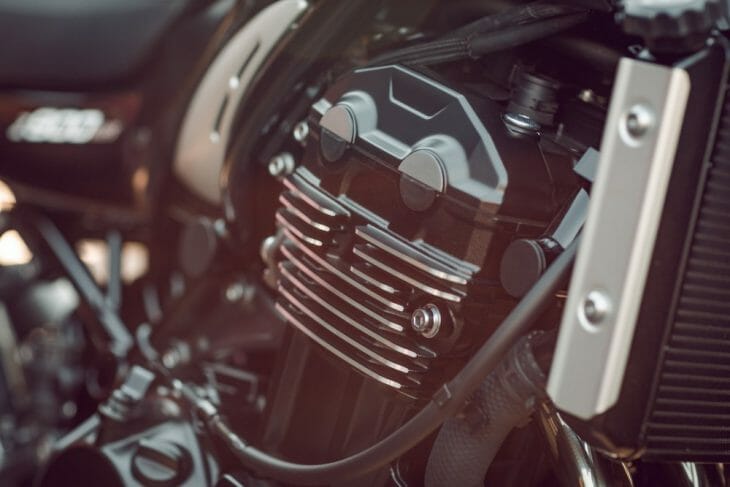 Kawasaki engineered old air-cooled-style cooling fins into the cylinder block to make it look even more like a ’70s refugee.
Kawasaki engineered old air-cooled-style cooling fins into the cylinder block to make it look even more like a ’70s refugee.
The Z900 motor came in for an extensive overhaul before it joined the retro party, with Kawasaki’s boffins moving the power down to concentrate on low- to mid-range performance, rather than superbike-style top-end craziness. Achieved via changing cam timing, compression, a heavier flywheel, final drive ratio and the exhaust design, the RS has plenty of torque down low as it pulls deceptively hard from canyon hairpins in higher than normal gears. But it’s also an area that presents a problem.
The RS’s throttle response in the first three gears in mid-to-high revs is quite jerky and not easy to dial in small increments of throttle. The throttle response is too on/off and it becomes really quite irritating when you’re riding twisty roads/trying to hold a line, and dial in the throttle and you want more predictable acceleration.
As the gears climb higher and the revs drop and the load reduces on the engine, the throttle issue starts to solve itself. It’s good this is the case because more often than not I would run the bike a gear or sometimes two higher than I normally would just to experience this new found bottom-end torque that is lacking on the Z900, where solid power only really starts to come in above 6000rpm.
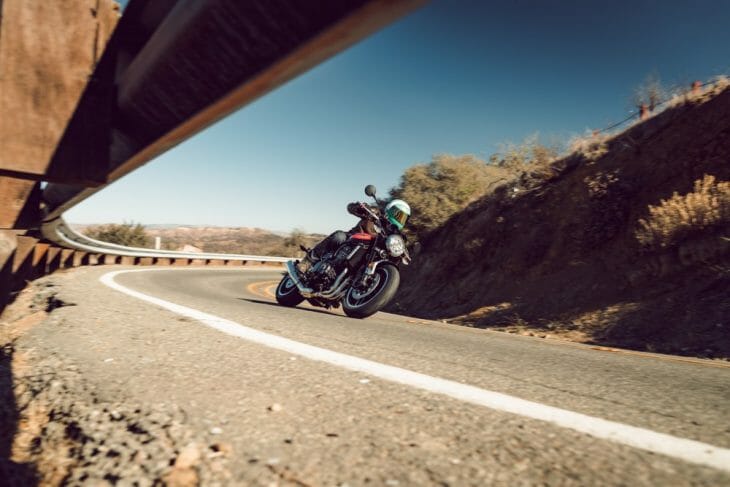 Throttle response could be smoother, especially in long corners like this one.
Throttle response could be smoother, especially in long corners like this one.
Trouble is, the Z900 doesn’t have this throttle response issue—it’s a silky-smooth example of what Kawasaki can do—so to have this problem on a bike costing the best part of $2500 more with the same base motor is disappointing.
Everything else about the powerplant and the way it transmits the go to the rear wheel is done beautifully. Fueling at low revs in high gears is well-mapped, which when combined with the lower final drive from the Z900 makes the 900RS good fun when the pace isn’t too hot.
There are no variable engine maps on the 900RS, but for your extra $2500 you do get two-stage Kawasaki TRaction (sic) Control (KTRC), an excellent system you’ll soon forget is there, if you notice it at all.
The gearbox action, coupled with the cable-actuated, slip and assist clutch, is direct and smooth, even if the new gearboxes we rode at the launch were a touch stiff. This will no doubt fade away with more use and we’ll be getting a long-term 900RS soon so we’ll be able to tell you if this is the case.
Fancy Dress Party
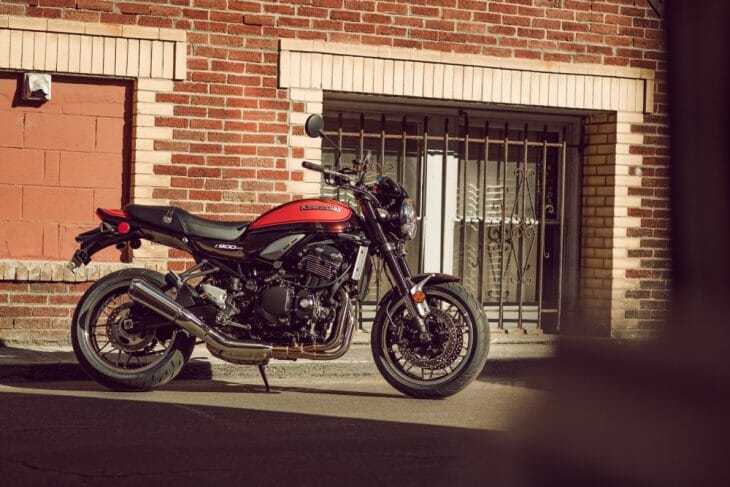 Kawasaki nailed the styling on the Z900RS.
Kawasaki nailed the styling on the Z900RS.
Kawasaki hasn’t just slapped together a Z900 chassis and given it some new clothes. The steel trellis unit was revised so the teardrop tank could be fitted, and the weight balance has been shifted slightly by raising the front and lowering the rear, giving the chassis a more neutral stance.
This makes the Z900RS not quite the weapon as the Z900 is in the twisties, but it will still be happy to play along if you want to get up it on Sunday morning. The suspension is set quite soft, and you will reach the limits of it quite quickly if you ride the bike with a little too much aggression—its damping rates are engineered for medium pace cruising. As Kawasaki Product Manager, Croft Long, put it to me, “The suspension is designed to give you plenty of feedback and make you feel like you’re going fast, without going over the top.” It’s another example of the kid not being as aggressive as the dad.
As such, the ride on roads that are not too chopped up is supremely smooth. The 900RS will glide along, the soft suspension combining with the relaxed riding position to make the rider appreciate some of the slower speeds in life.
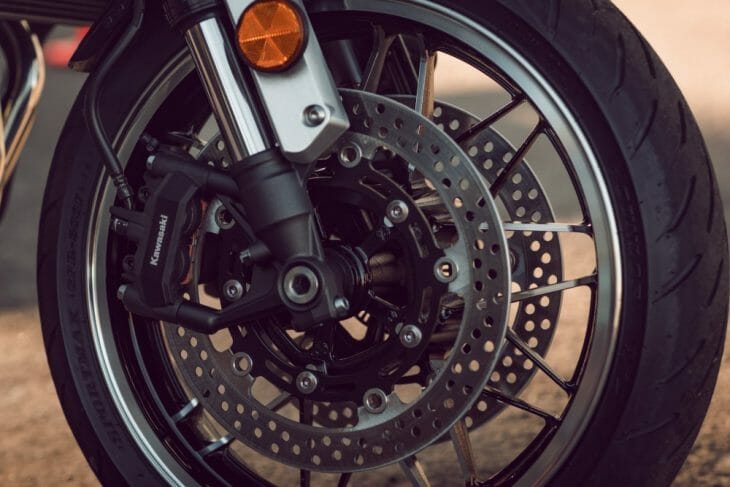 The brakes are actually higher-spec than you’ll get with the Z900.
The brakes are actually higher-spec than you’ll get with the Z900.
A 900RS rider will get some higher-spec brakes in the four-piston monobloc calipers compared to the conventionally mounted calipers of the Z900. They are exceptional stoppers, clamping down on the twin 300mm discs and giving lots of power to haul you up with great feel at the lever. The rear is hauled up by a single piston caliper biting down on a 250mm disc.
The Z900RS is not the second coming of a legend. Instead, it’s a nod to the past without actually living in it. I would have loved the Z900RS even more than I do had the throttle response not let the overall package down slightly because the rest of the bike varies from good to excellent. The punchy low-down torque, gearbox and suspension action—all good. Styling-wise, this bike is a home run, and straight to the top of the looks department for Kawasaki’s current model lineup.
At $10,999 for the Metallic Flat Spark Black and $11,1999 for the Candytone Brown/Candytone Orange paint scheme tested here, the Z900RS is in the mid-price range for a modern retro bike, falling quite a bit shorter than the BMW R nineT’s $15,395 MSRP and above the Yamaha XSR900, which retails for $9499. But the fact is, neither of these two admittedly brilliant bikes has the heritage and aura surrounding them like the Z900RS—and that alone will help them sell a bucketload of Z900RS’s to everyone from back-in-the-day riders to people that just simply want to look cool.
What’s been changed?
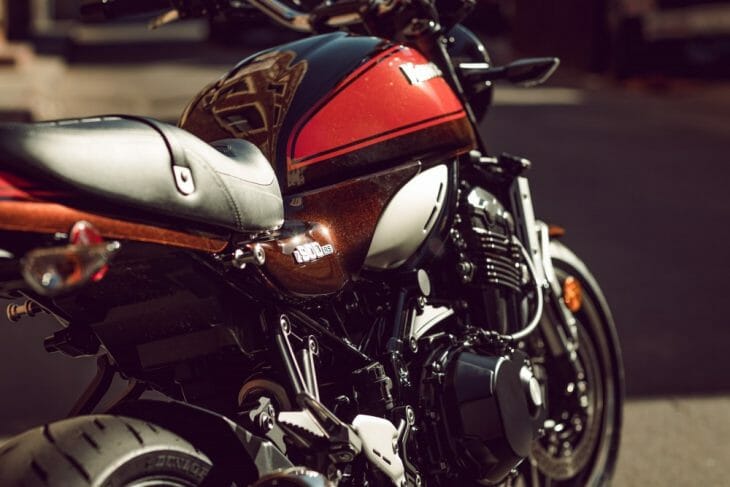 There’s a Z900 under those clothes, but the changes amount much more than an outfit change.
There’s a Z900 under those clothes, but the changes amount much more than an outfit change.
The Z900 came in for a significant overhaul as it morphed into the 900RS. The motor is still the 948cc, DOHC, liquid-cooled, inline four-cylinder unit as before, but the cam profiles have shorter intake and exhaust durations (248° intake and 244° exhaust), as part of the formula for low-to-mid-range performance.
The compression ratio has been dropped a point to 10.8:1, the flywheel mass has been beefed up by 12 percent. The first gear is shorter and the sixth gear taller—again, all changes aimed at the getting you up and moving fast but making for a more relaxed ride at highway speeds.
Kawasaki is particularly proud about the 900RS’s exhaust. Made from stainless steel, the exhaust is subject to a three-stage buffing process to give it that glaring chrome look. And it’s the first exhaust to come out of KHI that has enjoyed the presence of sound engineers to make sure the note is just right.
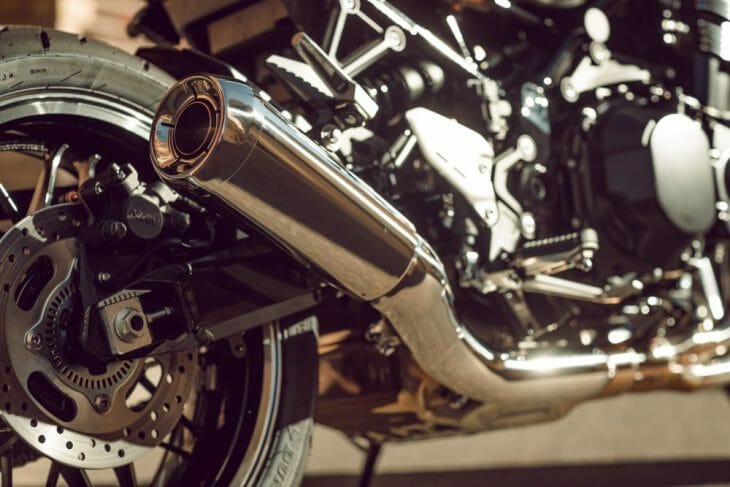 More work went into this exhaust than you’d believe.
More work went into this exhaust than you’d believe.
At low rpm, the exhaust gasses escape the engine in a straight line, while at high rpm, an additional passage route is used that houses glass wool packing and different fiber density to give the exhaust those deep, dulcet tones.
As for the chassis, the Z900RS uses the same lightweight steel trellis style layout that first appeared on a modern Kawasaki with the supercharged H2 and later the Z900. The top frame rails have been modified to allow the fitment of the teardrop gas tank, and the rear frame/subframe (it can’t be detached) needed to be modified to fit the long one-piece seat.
Up front, the upper triple clamp has increased its offset by 6mm and has a slightly reduced trail over the Z900, with the inverted suspension giving 10-way compression, 12-way rebound, and preload adjustment. The rear suspension is a monoshock that comes with preload and rebound damping adjustment.
On the electronics side you get ABS and two-stage traction control, but no adjustable riding modes (the Z900 only gets ABS). CN
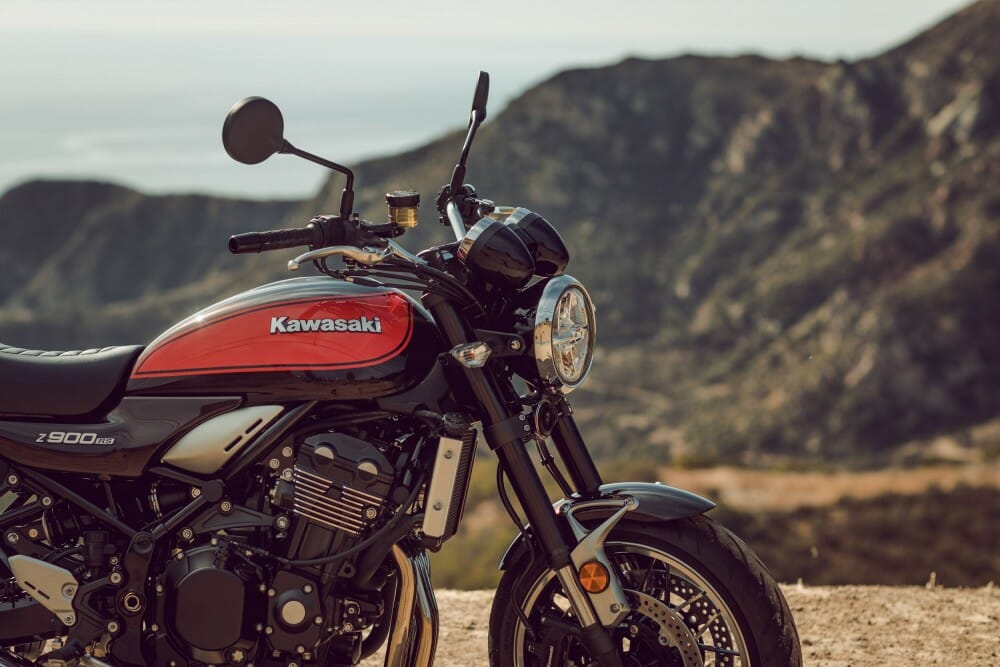
SPECIFICATIONS: 2018 Kawasaki Z900RS
|
|
Engine:
|
Inline four-cylinder, DOHC, 16-valve, liquid-cooled
|
|
Displacement:
|
948cc
|
|
Bore x stroke:
|
73.4 x 56mm
|
|
Compression ratio:
|
10.8:1
|
|
Clutch:
|
Wet multi-plate
|
|
Transmission:
|
Six-speed
|
|
Chassis:
|
Tubular steel trellis frame
|
|
Front suspension:
|
Inverted fork with adjustable compression and rebound damping, and spring preload. 4.7
inches of wheel travel
|
|
Rear suspension:
|
Horizontal back-link swingarm with stepless adjustable rebound damping and spring preload adjustment. 5.5 inches of wheel travel
|
|
Front brake:
|
300 mm dual semi-floating discs, radially-mounted dual monobloc four-piston calipers, ABS as standard
|
|
Rear brake:
|
250 mm disc, single-piston caliper with ABS as standard
|
|
Front tire:
|
120/70 ZR17 Dunlop GPR-300F
|
|
Rear tire:
|
180/55 ZR17 Dunlop GPR-300
|
|
Rake:
|
25.4°
|
|
Wheelbase:
|
58.1 in.
|
|
Seat height:
|
31.5 in.
|
|
Fuel capacity:
|
4.5 gal
|
|
Weight:
|
471.9 lbs (curb, claimed).
|
|
Color:
|
Candytone Brown/Candytone Orange, Metallic Spark Black
|
|
MSRP:
|
$10,999 for the Metallic Flat Spark Black and $11,1999 for the Candytone Brown/
Candytone Orange (tested here)
|
Click here for more Kawasaki motorcycle reviews and news.
Click here to read this in the Cycle News Digital Edition Magazine.